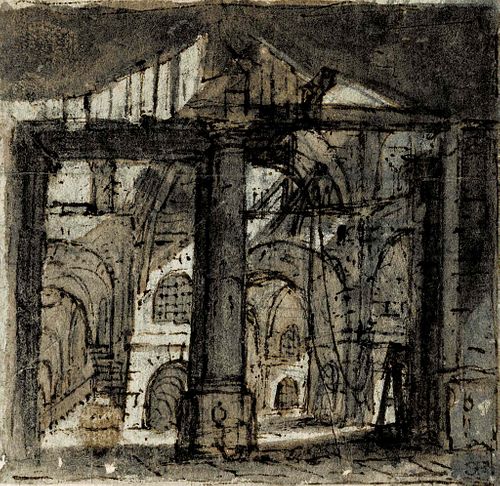Attr. to Giovanni Battista Piranesi, It. 1720-1778, Interior View, Ink and wash on paper, framed under glass
About Seller
312 Gannett Drive
South Portland, ME 04106
United States
At Barridoff Galleries, we seek out and find compelling, beautiful, relevant works of art. For us, it’s never just another auction. It’s an opportunity to help buyers and sellers of fine art realize their potential by establishing that special connection in their appreciation of fine art. Fine art s...Read more
Two ways to bid:
- Leave a max absentee bid and the platform will bid on your behalf up to your maximum bid during the live auction.
- Bid live during the auction and your bids will be submitted real-time to the auctioneer.
Bid Increments
| Price | Bid Increment |
|---|---|
| $0 | $25 |
| $100 | $50 |
| $500 | $100 |
| $2,000 | $250 |
| $5,000 | $500 |
| $10,000 | $1,000 |
| $25,000 | $2,500 |
| $50,000 | $5,000 |
| $100,000 | $10,000 |
| $1,000,000 | $100,000 |
About Auction
Mar 19, 2022
Barridoff Auction's Spring 2022 International Fine Art Sale Barridoff Auctions fineart@barridoff.com
- Lot Description
Attr. to Giovanni Battista Piranesi
(It. 1720-1778)
Interior View
Ink and wash on paper, framed under glass
Stamped "EF" l.r. of image, "Piran" inscribed l.r. of sheet, "8" inscribed l.l. of sheet
3 3/4" x 7 1/8" actual, 8 5/8" x 9 3/16" framedProvenance:
Estate of Donald Brenwasser, New JerseyOther Notes:
"EF" are the initials of noted architect and collector of old master drawings Edmond Fatio (Swiss, 1871-1959)Excerpts From Assessment by Cory Barbis:
A full copy of this assessment is available upon request
"Artwork is an original architectural sketch done on quality rag paper in pen and brush using warm black and sepia toned inks and washes. In some areas, graphite pencil is also visible. A microscopic examination of the work indicates that graphite pencil was first laid down as an outline; then, the artist “blocked” in further details in black ink using both pen and brush. Four distinct washes were applied by brush including a dark warm grey applied to the shadows. Additionally, a neutral medium grey, a lighter rose toned gray and an opaque medium/light grey were also used. Finally, detailing in black ink applied by pen was done to further define the image.
Visual examination of the paper can not precisely set a date of manufacture; however, from both it’s patina and construction, we identify it as being similar to paper found on drawings made by European “Old Masters”.
The unusual subject matter and the artist’s distinctive technique, style and choice of media - including the type of paper that was used – suggests this could be a sketch by the 18th century Italian artist, Giovanni Battista Piranesi. A digital search of the National Gallery of Art found at least 21 original Piranesi drawings. Additional sketches and drawings by the artist were found in the National Archives of Scotland and in the British Museum digital archives. All of these images share subject matter, technique, artistic style, and similar use of media with the artwork being examined.
As an engraver, Piranesi was well-known for his expansive, Italian architectural scenes. The most famous of these would have to be a series of fantastical engravings known as, “Invenzioni Capric di Carceri” – or the “Imaginary Prison Series.” In this series, Piranesi began to use an exaggerated scale of size, impossible geometry and multiple vanishing points as a way to create an oppressive and foreboding atmosphere to his art. The first printing of 14 prints in this series began around 1749 with a second state of 16 prints reworked and issued in 1761.
An examination of the “Imaginary Prison Series” and the original drawing reveal they have many elements in common. Both show large arched openings and heavy grates across windows with ropes hanging from ceilings and wooden braces. Out of the 16 prints in the prison series, one print commonly known as, “The Saw Horse” is of particular interest in that it shares one important element with the drawing being examined – suggesting that it may have been an early preparatory sketch for the engraving.
As seen in [the second state of the engraving commonly titled, “The Saw Horse”], a saw horse is prominently placed in the lower right. In the original drawing, the “A” frame and top of a saw horse is also visible in the lower right.
The artistic materials used, plus the style and subject matter of the sketch all are consistent with known examples of Piranesi sketches and engravings. The fact that there is a saw horse visible in this “preparatory” sketch is of particular interest in that, as far as we know, Piranesi only included a saw horse once in all of his engravings. Further forensic examination of this work to accurately date the paper and to analyze and identify the materials used would be warranted at this point. This information, along with an examination by an expert in Piranesi’s works would be the next step in having this work attributed to the artist.The artistic materials used, plus the style and subject matter of the sketch all are consistent with known examples of Piranesi sketches and engravings. The fact that there is a saw horse visible in this “preparatory” sketch is of particular interest in that, as far as we know, Piranesi only included a saw horse once in all of his engravings. Further forensic examination of this work to accurately date the paper and to analyze and identify the materials used would be warranted at this point. This information, along with an examination by an expert in Piranesi’s works would be the next step in having this work attributed to the artist."Good appearance. Good condition. Minor toning likely.Condition
- Shipping Info
-
Shipping arrangements and all packing and shipping charges are the responsibility of the buyer. Barridoff Auctions assumes no responsibility of any kind for providing this service. For your convenience, our in-house partner Eastern Art Services would be happy to provide a quote to pack and ship your items purchased at the auction. If you are not using our in-house partner, once you have made arrangements with the shipping service of your choice, please send an email to fineart@barridoff.com releasing your purchase to be shipped, include the lot number and any additional pertinent details. After we receive your release, we will coordinate the details of pick-up with your designated shipper. You will receive an email confirmation when your item(s) have been retrieved.
-
- Payment & Auction Policies
-
Available payment options
You can pay by card, cash, check, or wire transfer. To complete payment please call us at 207-772-5011. Please note that credit card payments are for the buyer's convenience, and as all sales are final, buyer agrees that by paying with credit card they will not chargeback or otherwise stop or reverse payment on items won. Thank you
-
-
- Buyer's Premium



 EUR
EUR CAD
CAD AUD
AUD GBP
GBP MXN
MXN HKD
HKD CNY
CNY MYR
MYR SEK
SEK SGD
SGD CHF
CHF THB
THB























